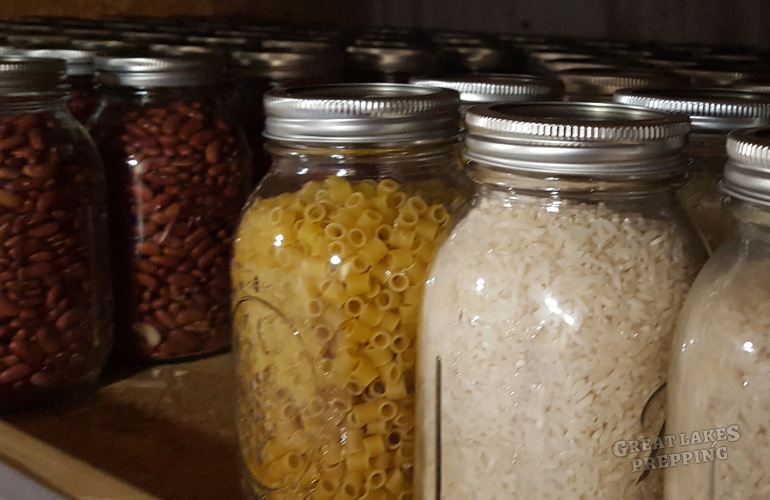How to Properly Store Canned Goods for Longer Shelf Life

While canned goods from the store and food you have personally canned in mason jars can last for a fairly long time, you will get the most shelf life when you ensure that they are properly stored. You will end up wasting money and time, and encounter food safety risks if you do not take care to keep your cans and jars in the right place and under the right circumstances.
When it comes to shelf stable foods and food safety, there are a few factors that will always come into play. The following are the primary “enemies” of food freshness:
- Oxygen
- Bacteria
- Light
- Heat
- Freezing
- Moisture
- Pests
Depending on what sort of food you’re storing, one or more of these “food enemies” will be a factor to be considered. Let’s break them down and discuss individually:
Oxygen
This is Food Safety Enemy #1. Nearly every shelf-stable food preservation method and practice involves removing oxygen from, and keeping oxygen out of, your food. The cans of soup you buy at the store, the pickles you’ve canned at home, packages of freeze-dried meals, and even bags of beef jerky all undergo a process by which oxygen is removed from the container. Oxygen is what allows fruit to rot. It’s what allows meat to become rancid. It’s what allows bacteria to flourish. Oxygen is needed for practically every process in which good food turns bad. Even with dry goods, oxygen causes food to go stale.
The good news is that the very act of processing and packaging canned goods takes care of this “enemy”. Canned goods from the store undergo industrial-grade heat and pressure processes which result in oxygen being removed. Hot water bath and pressure canning at home purges oxygen from your jars. Dried goods stored in mason jars will have the air sucked out with a vacuum-sealer machine. Even freeze-dried food products include oxygen absorber packets in the packaging.
Bacteria
Bacteria is ultimately the end result of most of the other “enemies”. Oxygen, heat, moisture, and freezing can all allow bacteria to grow in one way or another. The initial processing of canned goods is designed to kill all traces of bacteria, and the methods of storage are meant to keep new bacteria from forming.
Light
Prolonged exposure to light can cause stored foods to lose their quality, in taste, texture, and nutritional value. Light has been found to contribute to color and vitamin loss. With a lot of packaging, this isn’t a problem because the container is opaque. Canned foods from the store, Mylar bags of beef jerky, etc. But food you’ve canned in transparent mason jars are exposed on nearly all sides to any ambient light. For this reason, it’s important that you store your transparent containers in a dark place. A thick cardboard box, a cupboard, a closet.
Heat
Ambient heat not only increases the chances that bacteria could form inside your canned goods, but it can also lead to the degradation of the container itself. It’s ideal to store your cans and jars of food at temperature of no higher than 70 degrees Fahrenheit, and definitely not higher than 85 degrees Fahrenheit.
Freezing
While freezing won’t make your food unsafe in and of itself, it will destroy your canned goods in a more indirect way. Allowing a sealed jar or can to freeze is almost surely going to compromise the seal (and therefore the food safety) of the container. Foods expand when frozen, which will damage metal cans. It will cause the lid seal of a mason jar to fail, and possibly crack the glass jar itself. The moment your container is breached, consider the food inside to be ruined (especially if there is broken glass present!)
And even if freezing temperatures didn’t compromise your jars and cans, fluctuating temperatures would ultimately affect the taste and texture of the food itself.
Ideal temperatures to store canned goods are 50-70 degrees Fahrenheit. You can store them at colder temperatures, as long as it’s not below freezing, but you should be careful to avoid a lot of temperature fluctuation. Between 50 and 70 degrees is pretty safe. But storing food in a location with temperatures that swing wildly from 35 to 70 and back will hasten food spoilage worse than keeping that food at a consistent 70 degrees.
Moisture
There’s two different aspects of this “enemy” to discuss. The first really only pertains to dry goods and “interior moisture”. I store a lot of dry goods in sealed mason jars, such as grains, rice, oats, beans, and dehydrated vegetables. The reason these can be safe and shelf stable for a long time is because they are completely devoid of oxygen and moisture. Even a small amount of moisture, when not processed with heat and/or pressure, will foster bacteria.
The second aspect of this enemy pertains to exterior moisture. Moisture leads to surface rust. Surface rust leads to compromised cans and jars. Therefore, storing your cans and jars in a dry place is a must. If your pantry is located in a basement or room that is particularly humid, use a dehumidifier. Do whatever you can to keep your food from sitting in a dank, wet environment.
Pests
This one is pretty straightforward. Pests aren’t a major problem when it comes to metal cans and glass jars, but they are still a potential “enemy”. Dead insects or rodent droppings are obviously unsanitary and potentially dangerous, so be sure to inspect cans and jars before opening. Particularly if they have been sitting in storage for quite some time, careful inspect and wipe down any containers before opening them. The last thing you want is for those “droppings” to fall into your food as you open the can.
It’s said that rats are capable of chewing through a metal can, though I’ve never seen it happen. But for good measure with regards to safety and sanitation in general, stay aware of any rodent problems that may arise. If you see signs of mice or rats, address it immediately. Set up traps or whichever rodent-control method you prefer. If needed, move your stored food somewhere else temporarily while you handle the pests and give the entire area a deep clean.
Summary
By following some basic rules, your jars and cans of food will be perfectly tasty and safe to eat for months or years to come. Just consider the list of “food enemies” when storing your goods, and you will be in good shape.
- Store in a dark place, especially away from sunlight
- Store in a place between 50 and 70 degrees Fahrenheit
- Store in a place that has little to no humidity
- Regularly inspect for damage caused or waste left by pests

